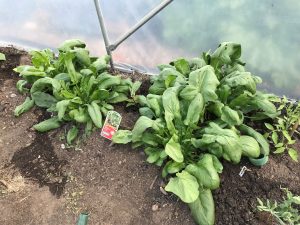What’s happening now 14/05/18
I can’t believe it is nearly a month since I wrote the last post on the blog. In that time everything has started to grow and the weather is currently quite warm: the polytunnel needs frequent watering. this week has been a week of planting out so that I can make a bit of space in my greenhouse and sow more seeds!
 To my surprise, the garlic in the polytunnel had started to bolt. Last year, I planted all of my garlic outside and each clove sprouted due to the cold and then hot then cold weather. The bulbs were very small and it really wasn’t worth it. This year, I decided to plant half in the tunnel and half outside. The half that is outside is not ready yet but this lot was. I pulled it, strung it up to dry out and planted some aubergines into the space they left.
To my surprise, the garlic in the polytunnel had started to bolt. Last year, I planted all of my garlic outside and each clove sprouted due to the cold and then hot then cold weather. The bulbs were very small and it really wasn’t worth it. This year, I decided to plant half in the tunnel and half outside. The half that is outside is not ready yet but this lot was. I pulled it, strung it up to dry out and planted some aubergines into the space they left.
The heads on these are a reasonable size and so I will save one or two to grow again next year. Some people on the allotments have been planting garlic that they have kept for years and now have plants that are especially adapted to their soil and watering conditions.

The broad beans have started to produce and I have picked a kilogram from the tunnel again. They were small, juicy and tender and we ate them in salads and as a vegetable with small carrots and asparagus. We are eating a lot of asparagus at the moment. So much so in fact that I might have to try and freeze some. It would be great to have an asparagus omelette in the summer or to include some in stir fries throughout the year.
 It is the first year that I have grown spring onions, red and white, and they are doing well. I keep thinning them and eating the thinnings in stir fries. The carrots are also bushing up and starting to thicken so these are also being thinned and eaten. My carrots outside have not germinated particularly well so my next visit to the plot will involve resowing both carrots and parsnips.
It is the first year that I have grown spring onions, red and white, and they are doing well. I keep thinning them and eating the thinnings in stir fries. The carrots are also bushing up and starting to thicken so these are also being thinned and eaten. My carrots outside have not germinated particularly well so my next visit to the plot will involve resowing both carrots and parsnips.
 The main job this week has been planting out in the polytunnel. I have a lot of tomatoes to plant: Costoluto, Sungold, Zlatava, Black Krim, Green Zebra, Tigerella and Black Cherry. You can’t have too many tomatoes, can you? I have interplanted several varieties of lettuce and am hoping that the tomatoes will provide a bit of shade for them until it gets too hot in there. I also planted lettuce outside around my courgettes which should stagger production.
The main job this week has been planting out in the polytunnel. I have a lot of tomatoes to plant: Costoluto, Sungold, Zlatava, Black Krim, Green Zebra, Tigerella and Black Cherry. You can’t have too many tomatoes, can you? I have interplanted several varieties of lettuce and am hoping that the tomatoes will provide a bit of shade for them until it gets too hot in there. I also planted lettuce outside around my courgettes which should stagger production.

The spinach has been prolific and will very soon need to be pulled even if it hasn’t bolted: I need the space – there are more tomatoes to go in! This variety, Medania, is supposed to be good in heat and drought so perfect for a polytunnel. I hate it when you have to take something out because you don’t have enough space.
What’s going well on your plot at the moment?